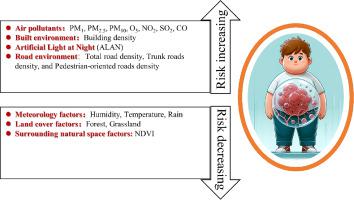当前位置:
X-MOL 学术
›
Sci. Total Environ.
›
论文详情
Our official English website, www.x-mol.net, welcomes your feedback! (Note: you will need to create a separate account there.)
Association of the external environmental exposome and obesity: A comprehensive nationwide study in 2019 among Chinese children and adolescents
Science of the Total Environment ( IF 9.8 ) Pub Date : 2024-04-12 , DOI: 10.1016/j.scitotenv.2024.172233 Li Chen , Yang Qin , Yi Zhang , Xinli Song , RuoLin Wang , Jianuo Jiang , Jieyu Liu , Tongjun Guo , Wen Yuan , Zhiying Song , Yanhui Dong , Yi Song , Jun Ma
Science of the Total Environment ( IF 9.8 ) Pub Date : 2024-04-12 , DOI: 10.1016/j.scitotenv.2024.172233 Li Chen , Yang Qin , Yi Zhang , Xinli Song , RuoLin Wang , Jianuo Jiang , Jieyu Liu , Tongjun Guo , Wen Yuan , Zhiying Song , Yanhui Dong , Yi Song , Jun Ma

|
Children and adolescents are particularly vulnerable to the effects of various environmental factors, which could disrupt growth processes and potentially lead to obesity. Currently, comprehensive and systematic assessments of these environmental exposures during developmental periods are lacking. Therefore, this study aims to evaluate the association between external environmental exposures and the incidence of obesity in children and adolescents. Data was collected from the 2019 Chinese National Survey on Students' Constitution and Health, including 214,659 Han children aged 7 to 19. Body Mass Index (BMI) and BMI-for-age z-score (zBMI) were the metrics used to assess overweight and obesity prevalence. The study assessed 18 environmental factors, including air pollutants, natural space, land cover, meteorological conditions, built environment, road conditions, and artificial light at night. Exposome-wide association study (ExWAS) to analyze individual exposures' associations with health outcomes, and Weighted Quantile Sum (WQS) to assess cumulative exposure effects. Among the children and adolescents, there were 24.2 % participants classified as overweight or obesity. Notably, 17 out of 18 environmental factors exhibited significant associations with zBMI and overweight/obesity. Seven air pollutants, road conditions, and built density were positively correlated with higher zBMI and obesity risk, while NDVI, forests, and meteorological factors showed negative correlations. Co-exposure analysis highlighted that SO2, ALAN, PM10, and trunk road density significantly increased zBMI, whereas rainfall, grassland, and forest exposure reduced it. Theoretically reduction in the number and prevalence of cases was calculated, indicating potential reductions in prevalence of up to 4.51 % for positive exposures and 5.09 % for negative exposures. Notably, substantial reductions were observed in regions with high pollution levels. This large-scale investigation, encompassing various environmental exposures in schools, highlights the significant impact of air pollution, road characteristics, rainfall, and forest coverage on childhood obesity.
更新日期:2024-04-12



























 京公网安备 11010802027423号
京公网安备 11010802027423号